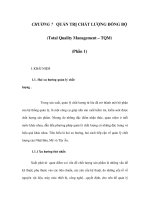Human Rights Indicators in Development phần 1 pps
Bạn đang xem bản rút gọn của tài liệu. Xem và tải ngay bản đầy đủ của tài liệu tại đây (14.41 MB, 10 trang )
AN INTRODUCTION
Human Rights
Indicators in
Development
Human Rights Indicators in Development
H
uman Rights Indicators in Development is part of the World Bank Studies series. These papers
are published to communicate the results of the Bank’s ongoing research and to stimulate
public discussion.
This paper was written to provide development practitioners with an introduction on the rele-
vance, design, and use of human rights indicators in development policy and practice. It offers a
basic conceptual framework about the relationship between rights and development, including in
the World Bank context. It describes a range of methodological approaches on human rights mea-
surement, exploring in general terms different types of human rights indicators and their potential
implications for development at three different levels of convergence or integration.
This publication is one of a series of World Bank Studies produced by the Legal Vice-Presidency
to share knowledge and innovative legal solutions on Law, Justice and Development issues.
World Bank Studies are available individually or on standing order. The World Bank Studies
series is also available online through the World Bank e-library (www.worldbank.org/elibrary).
A WORLD BANK STUDY
Siobhán McInerney-Lankford
Hans-Otto Sano
ISBN 978-0-8213-8604-0
SKU 18604
HumanRightsWP10_Cover.indd 1HumanRightsWP10_Cover.indd 1 10/7/10 11:28:22 AM10/7/10 11:28:22 AM
WORLD BANK STUDY
Human Rights Indicators in
Development
An Introduction
Siobhán McInerney-Lankford
Hans-OĴ o Sano
HumanRightsWP10.indd iHumanRightsWP10.indd i 10/7/10 10:18:59 AM10/7/10 10:18:59 AM
Copyright © 2010
The International Bank for Reconstruction and Development / The World Bank
1818 H Street NW
Washington DC 20433
Telephone: 202-473-1000
Internet: www.worldbank.org
All rights reserved
1 2 3 4ȳȳȳ13 12 11 10
World Bank Studies are published to communicate the results of the Bank’s work to the
development community with the least possible delay. The manuscript of this paper therefore
has not been prepared in accordance with the procedures appropriate to formally-edited texts.
Some sources cited in this paper may be informal documents that are not readily available. This
volume is a product of the staě of the International Bank for Reconstruction and Development /
The World Bank. The fi ndings, interpretations, and conclusions expressed in this volume do not
necessarily refl ect the views of the Executive Directors of The World Bank or the governments
they represent.
The World Bank does not guarantee the accuracy of the data included in this work. The
boundaries, colors, denominations, and other information shown on any map in this work
do not imply any judgment on the part of The World Bank concerning the legal status of any
territory or the endorsement or acceptance of such boundaries.
Rights and Permissions
The material in this publication is copyrighted. Copying and/or transmiĴ ing portions or all of
this work without permission may be a violation of applicable law. The International Bank for
Reconstruction and Development / The World Bank encourages dissemination of its work and
will normally grant permission to reproduce portions of the work promptly.
For permission to photocopy or reprint any part of this work, please send a request with
complete information to the Copyright Clearance Center Inc., 222 Rosewood Drive, Danvers,
MA 01923, USA; telephone: 978-750-8400; fax: 978-750-4470; Internet: www.copyright.com.
All other queries on rights and licenses, including subsidiary rights, should be addressed
to the OĜ ce of the Publisher, The World Bank, 1818 H Street NW, Washington, DC 20433, USA;
fax: 202-522-2422; e-mail:
ISBN: 978-0-8213-8604-0
eISBN: 978-0-8213-8576-0ȳȳȳȳȳȳȳȳȳDOI: 10.1596/978-0-8213-8604-0
Library of Congress Cataloging-in-Publication Data
McInerney-Lankford, Siobhán Alice, 1974–
Human rights indicators in development : an introduction / Siobhán McInerney-Lankford and
Hans-OĴ o Sano.
ȳȳp. cm.
ȳISBN 978-0-8213-8604-0
ȳ1.ȲHuman rights.ȳ2.ȲEconomic development.ȳI.ȲSano, H O. (Hans-OĴ o)ȳII.ȲWorld Bank.
III. Title.
ȳJC571.M28 2010
ȳ323 dc22
2010038085
HumanRightsWP10.indd iiHumanRightsWP10.indd ii 10/7/10 10:19:04 AM10/7/10 10:19:04 AM
iii
Foreword v
Abstract vi
Acknowledgments vii
Abbreviations viii
Chapter 1. Introduction 1
Chapter 2. Human Rights and Development: “Toward Mutual Reinforcement” 3
Introduction 3
World Bank Approach to Convergence 5
Role of Human Rights in Development 6
Rights-Based Approaches to Development 8
Tensions 9
Chapter 3. Human Rights Indicators 14
Introduction 14
Designing Indicators 14
Streamlining Human Rights Indicators 15
Data Sources 16
Types of Human Rights Indicators 18
Indicators Measuring Compliance with Legal Obligations 18
Human Rights Indicators in Development Practice 21
Chapter 4. Integrating Human Rights into Development: Indicator Implications 27
Introduction Human Rights and Development: Levels and Degrees
of Convergence 27
A Framework Outlining the Modes of Integration 27
Human Rights Indicators at Three Levels of Convergence of Human Rights
and Development 28
Dimensions: Substantive Overlap 30
Integration of Human Rights Principles 31
Equity and Equality 33
Accountability 34
Participation 36
Obligations 36
Chapter 5. Conclusions 45
Chapter 6. Literature Review 47
Appendix A. The Core International Instruments and the Treaty Bodies 55
Appendix B. A Structure of Human Rights Indicators 56
Contents
HumanRightsWP10.indd iiiHumanRightsWP10.indd iii 10/7/10 10:19:04 AM10/7/10 10:19:04 AM
iv Contents
Appendix C. Human Rights Indicators Sources 57
Appendix D. Defi nition of Right to Water 60
Appendix E. Defi nition of the Right to Education 62
Appendix F. Defi nition of the Right to Social Security 64
Appendix G. Implementation of the Right to Development: AĴ ributes Criteria,
Subcriteria, and Indicators 66
List of Tables
Table 1.1. Example of Potential Tension between Human Rights and
Development Actors 10
Table 3.1. A Framework for the Elaboration of Human Rights Indicators 20
Table 3.2. Identifying Human Rights Indicators at Diě erent Levels of
Development Practice 23
Table 4.1. Three Modes of Human Rights Integration 29
Table 4.2. Nonexplicit Human Rights Integration: The Human Rights Dimensions
of Development 31
Table 4.3. Mainstreaming Human Rights Principles 32
Table 4.4. Assessing Human Rights Obligations 38
List of Figures
Figure 1.1. Intrinsic and Instrumental Roles of Human Rights in Development 7
Figure 4.1. Fulfi lling Human Rights Obligations of Developing States and of
States Acting as Donors: Human Rights Activities (A) and Indicators (I) 39
List of Boxes
Box 3.1. Indicator Defi nitions 15
Box 3.2. The Data Sources of Human Rights Research 17
Box 4.1. OECD Description of the Approaches of Donor Agencies 29
HumanRightsWP10.indd ivHumanRightsWP10.indd iv 10/7/10 10:19:04 AM10/7/10 10:19:04 AM
Foreword
v
T
he World Bank Study Human Rights Indicators in Development: An Introduction oě ers a
preliminary perspective on the relevance of human rights indicators to development
practice. It elucidates in general terms the signifi cance of human rights indicators for
development processes and outcomes, in particular through how they connect the
normative standards embodied in human rights and development data. This study
eě ectively outlines the assessment and diagnostic functions of human rights indicators in
the context of development, oě ering a review of methodological approaches on human
rights measurement, exploring in general terms diě erent types of human rights indicators
and their potential implications for development at three diě erent levels of convergence
or integration. The study also includes a basic conceptual framework for approaching the
relationship between rights and development and approaches to human rights integration
in development. The study contributes a worthwhile theoretic introduction to a complex
issue of growing relevance in a number of areas of development which may be of interest to
practitioners and scholars in a variety of institutional seĴ ings, including that of the WBG.
Human Rights Indicators in Development: An Introduction is one recent output of broader
World Bank Group eě orts underway to explore the relevance of human rights to its work.
The World Bank contributes to the realization of human rights in diě erent areas and in
diě erent ways, whether through improving poor people’s access to health, education, food
and water, promoting the participation of indigenous peoples in decision-making and or
promoting accountability, transparency and governance.
Most recently, the World Bank Group established a knowledge and learning program
supported by the Nordic Trust Fund (NTF). The program comprises a range of research,
analytical and operational activities across the World Bank Group designed to help the
World Bank develop a more informed view on human rights. It is aimed at improving
existing Bank involvement on human rights in the overall context of the Bank’s core mission
of promoting economic growth and poverty reduction. OPCS and LEG are pleased to
support the publication of this Study as part of that program and are grateful to the Danish
government for the generous support of the research upon which it is founded.
Hassane Cisse,
Deputy General Counsel,
Knowledge and Research,
Legal Vice Presidency,
The World Bank
HumanRightsWP10.indd vHumanRightsWP10.indd v 10/7/10 11:34:31 AM10/7/10 11:34:31 AM
vi
H
uman rights indicators are central to the application of human rights standards
in context and relate essentially to measuring human rights realization, both
qualitatively and quantitatively. They oě er an empirical or evidence-based dimension to
the normative content of human rights legal obligations and provide a means of connecting
those obligations with empirical data and evidence and, in this way, relate to human rights
accountability and the enforcement of human rights obligations. Human rights indicators
are important for both assessment and diagnostic purposes: the assessment function of
human rights indicators relates to their use in monitoring accountability, eě ectiveness,
and impact; the diagnostic purpose relates to measuring the current state of human rights
implementation and enjoyment in a given context, whether regional, country-specifi c, or
local.
This paper oě ers a preliminary review of the foregoing in the development context
and a general perspective on the signifi cance of human rights indicators for development
processes and outcomes. It is not intended to be prescriptive and does not provide specifi c
operational recommendations on the use of human rights indicators in development
projects. Nor does it advocate a particular approach or mode of integrating human rights
in development or argue for a rights-based approach to development.
This paper is designed to provide development practitioners with a preliminary view
on the possible relevance, design, and use of human rights indicators in development
policy and practice. It also introduces a basic conceptual framework about the relationship
between rights and development, including in the World Bank context. It then moves to
methodological approaches on human rights measurement, exploring in general terms
diě erent types of human rights indicators and their potential implications for development
at three levels of convergence or integration. The paper therefore oě ers a theoretical
introduction to a complex area of growing relevance in a number of areas of development
that may be of interest to practitioners and scholars in a variety of institutional seĴ ings.
Abstract
HumanRightsWP10.indd viHumanRightsWP10.indd vi 10/7/10 10:19:05 AM10/7/10 10:19:05 AM
vii
T
he authors are grateful to the Danish Government for the fi nancial support of this
project through the Danish Consultant Trust Funds administrated by the World Bank.
The authors thank Anne-Marie Leroy, Senior Vice-President and General Counsel, and
Hassane Cisse, Deputy General Counsel, for their leadership and support of this publication.
The authors are grateful to Kyle Peters, Director, Strategy and Country Services OPCS, and
Anders Zeħ lon (Nordic Trust Fund Coordinator) for their input on the study, and for NTF
support received for its publication. Thanks are also due to a number of current and former
staě of the Legal Vice-Presidency for intellectual input and support at a variety of stages
of the process: Roberto Dañino, Charles Di Leva, David Freestone, Adrian di Giovanni,
Danielle Malek, Marco Nicoli, Salman Salman, Lars Adam Rehof and Jaap van Opstal.
Particular thanks are due to the LEGVP Research and Editorial Board* which reviewed and
recommended the paper for publication. The authors are also grateful to Joachim Nahem,
who served as external peer reviewer, and to the colleagues from a number of agencies
and institutions with whom they have worked as part of the OHCHR Expert Group on
Human Rights Indicators since 2006: this paper has benefi ted immensely from the authors’
participation in that exercise, and especially from the insights of Martin Scheinin, Paul
Hunt, Rajeev Malhotra and Nicholas Fasel.
The last revision of the report was completed July 2010. Publication of this report was
made possible by the support of the Nordic Trust Fund.
Acknowledgments
*
Hassane Cisse, Editor in Chief; Kenneth Mwenda and Alberto Ninio, Chairs; Christina Biebesheimer,
Charles di Leva, Laurence Lauliot, Siobhán McInerney-Lankford, Vikram Raghavan, Kishor Uprety,
and Vħ ay Tata, Members.
HumanRightsWP10.indd viiHumanRightsWP10.indd vii 10/7/10 10:19:05 AM10/7/10 10:19:05 AM
viii
AAA Accra Agenda for Action
ABA American Bar Association
CAT Convention against Torture and other Cruel, Inhuman, or Degrading Treatment
of Punishment
CAS Country Assistance Strategies
CEDAW Convention on Elimination of All Forms of Discrimination against Women
CEELI Central European and Eurasian Law Initiative
CIRI Cingranelli-Richards Human Rights Data Project
CPIA Country Policy and Institutional Assessment
CRC Convention on the Rights of the Child
CRC-AC Optional Protocol to the Convention of the Rights of the Child on the
Involvement of Children in Armed Confl icts
CRC-SC Optional Protocol to the Convention of the Rights of the Child on the Sale of
Children, Child Prostitution, and Child Pornography
CRPD Convention on the Rights of Persons with Disabilities
DANIDA Danish International Development Assistance
DFID Department for International Development
DIHR Danish Institute for Human Rights
HDR Human Development Report
HR Human Rights
IBLF International Business Leaders Forum
IBRD International Bank for Reconstruction and Development
ICCPR International Covenant on Civil and Political Rights
ICERD International Convention on the Elimination of All Forms of Racial
Discrimination
ICESCR International Covenant on Economic, Social, and Cultural Rights
ICRMW International Convention on the Protection of the Rights of All Migrant
Workers and Members of Their Families
IDA International Development Association
IFI International Finance Institution
ILO International Labour Organization
IO International Organizations
IRAI IDA Resource Allocation Index
ISSA International Social Security Association
JAS Joint Assistance Strategies
HRCA Human Rights Compliance Assessment
KILM Key Indicators of the Labour Market
KJAS Kenya Joint Assistance Strategy
MDG Millennium Development Goals
OHCHR OĜ ce of the High Commissioner for Human Rights
OP Operational Policy
PRS Poverty Reduction Strategies
RBAs Rights-Based Approaches
SSA Sub-Saharan Africa
SSPTW Social Security throughout the World
Abbreviations
HumanRightsWP10.indd viiiHumanRightsWP10.indd viii 10/7/10 10:19:05 AM10/7/10 10:19:05 AM
Human Rights Indicators in Development ix
UDHR Universal Declaration of Human Rights
U.N. United Nations
UNDP United Nations Development Programme
UNGC United Nations Global Compact
UNPO The Unrepresented Nations and Peoples Organization
WDR World Development Report
WHOSIS World Health Organization Statistical Information System
HumanRightsWP10.indd ixHumanRightsWP10.indd ix 10/7/10 10:19:05 AM10/7/10 10:19:05 AM









